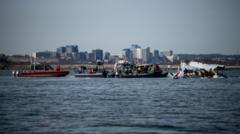The mid-air collision that occurred on Wednesday near Reagan National Airport, involving an American Airlines flight and a Black Hawk helicopter, has raised significant concerns about air traffic control staffing and procedural adherence. Transportation Secretary Sean Duffy noted that staffing levels at the tower were "not normal," as one controller was managing both helicopters and airplanes—tasks typically divided between two personnel. This consolidation of duties coincided with a critical period of air traffic, leading to potentially compromised oversight.
Reporting from CBS News indicates that during the time of the tragedy, the lone air traffic controller struggled to navigate the busy airspace, prompting investigations into FAA protocols and the appropriateness of their defenses. The National Transportation Safety Board (NTSB) has begun examining factors such as the helicopter's flying altitude and the rationale behind conducting a training mission at a peak traffic time—9 PM—when aviation movements are particularly high.
The helicopter, reportedly flying at an altitude of 200 feet, which matches the ceiling for that area, has sparked further scrutiny from officials. Duffy questioned the decision to execute training missions at such busy times, calling for better scheduling to ensure passenger safety.
While military officials confirmed that the helicopter crew was experienced and flew regular missions in support of senior leadership, the Transportation Secretary emphasized the ongoing understaffing crisis affecting over 90% of air traffic control facilities nationwide. He acknowledged controllers' exhaustion and the necessity of a comprehensive plan to address staffing shortages in the future.
As families of the 67 victims grieve, recovery efforts are ongoing to locate and retrieve all remains from the Potomac River. Civil officials assured that while challenges persist, their commitment to recover the victims remains steadfast, even amidst tragedies like a recent incident involving a diver hospitalized for hypothermia during recovery operations.
The investigation into the crash continues as many unanswered questions linger about safety procedures and operational management in densely populated airspace, shedding light on a systemic crisis that has developed within the nation's aviation sector.
Reporting from CBS News indicates that during the time of the tragedy, the lone air traffic controller struggled to navigate the busy airspace, prompting investigations into FAA protocols and the appropriateness of their defenses. The National Transportation Safety Board (NTSB) has begun examining factors such as the helicopter's flying altitude and the rationale behind conducting a training mission at a peak traffic time—9 PM—when aviation movements are particularly high.
The helicopter, reportedly flying at an altitude of 200 feet, which matches the ceiling for that area, has sparked further scrutiny from officials. Duffy questioned the decision to execute training missions at such busy times, calling for better scheduling to ensure passenger safety.
While military officials confirmed that the helicopter crew was experienced and flew regular missions in support of senior leadership, the Transportation Secretary emphasized the ongoing understaffing crisis affecting over 90% of air traffic control facilities nationwide. He acknowledged controllers' exhaustion and the necessity of a comprehensive plan to address staffing shortages in the future.
As families of the 67 victims grieve, recovery efforts are ongoing to locate and retrieve all remains from the Potomac River. Civil officials assured that while challenges persist, their commitment to recover the victims remains steadfast, even amidst tragedies like a recent incident involving a diver hospitalized for hypothermia during recovery operations.
The investigation into the crash continues as many unanswered questions linger about safety procedures and operational management in densely populated airspace, shedding light on a systemic crisis that has developed within the nation's aviation sector.



















